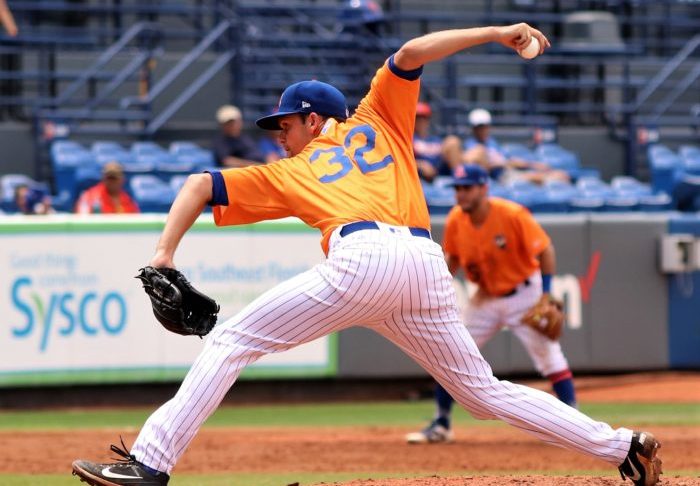
Photo by Ed Delany, MMN
There’s outperforming the competition, then there’s what Steve Villines has done to opposing hitters through a season-and-a-half of professional baseball.
The sidewinding right-hander from the University of Kansas has pitched at four levels since the Mets took him in the tenth round in 2017, and he’s found success everywhere he’s been. At Kingsport (R), he forced an unusual midseason promotion after just eight appearances. Villines then traveled t0 Brooklyn (SS-A), where he wrapped up a debut season in which he struck out 41 batters and walked just one.
In 2018, a rather conservative assignment placed the 23-year-old in Columbia (A), where he continued to blow his mid-to-high 80s fastball, slider, and changeup past South Atlantic League hitters. In a small sample size of 33.1 innings, Villines did record a 4.86 ERA, but his 1.63 FIP and .413 BABIP (in addition to other peripherals, such as a 23% pulled fly ball rate, which suggest he simply ran into some bad luck).
With St. Lucie, Villines has been even more dominant, striking out multiple batters in nearly half of his outings, and posting an outstanding .297 OPS. One of my favorite numbers when looking at Villines’ 2018 data is his 81% swinging strikeout rate between both levels. You can chalk that up to his deceptiveness and change-of-pace, which have led to the overpowering results.
I recently caught up with Steve to discuss his baseball background and where he’s at, as his first full professional season comes to a close.
In the month and a half you’ve been with St Lucie, what have you noticed in terms of how hitters approach you and in turn, how you have to approach them?
The biggest difference that I’ve noticed is that the hitters don’t give up at-bats. They have a better approach, can spoil pitches, and it makes me as the pitcher really work for the out. The way I have been trying to adjust is by working on all sides of the plate and just trying to make the hitter feel uncomfortable.
I’m sure you’ve been asked this a million times, but when and where did you pick up the sidearm slot?
Ever since I was younger I’ve always thrown from a 3/4 arm slot. I brought that arm slot into Kansas with me and as I was going through my freshmen year in the fall, I started to get a feel for dropping down lower and I started seeing results on the mound. Since then I’ve really been able to stay low, and the coaching staff has helped me just be consistent.
I know Joe Cavallaro also has that low slot as well, is that something you guys have talked about together?
Joe and I both started in Kingsport together last year, so we have talked about different ideas and approaches to hitters. Sometimes he will see something in my mechanics and give me some advice and vice-versa. It’s nice when someone else understands that arm angle.
What was your overall experience like playing at Kansas, especially under Coach Ritch Price, who’s been around the game for a long time?
Kansas was the best! I really wouldn’t trade my four years there for anything. The school as a whole has everything student-athlete could ask for. Without my coaches and teammates from Kansas I wouldn’t be where I am today. Coach Skip is an absolute legend and same with his whole coaching staff. He and his staff bring so much experience and knowledge to the game and help every player that comes through their program.
Would you say playing in a major conference like the Big 12 prepared you well for your first professional season?
The Big 12 always has some of the best teams in the nation, so having the opportunity to go up against that caliber of players definitely got me prepared for pro ball.
This past winter was the first time you weren’t in school during those months, what kind of routine were you able to get into to stay sharp?
This past offseason I actually went back to Kansas to finish up my degree. I stayed there until I reported for Spring Training. Being back on campus made it easy for me to stay in shape and prepare for the next season. I was able to use all the facilities on campus, and the coaches would let me throw bullpens and anything else I needed.
Being in the organization for about a year now, what sense have you gotten from coaches like Ron Romanick and Royce Ring and Jonathan Hurst about what they expect from their pitchers?
Working with a couple of different pitching coaches so far, the overall message has stayed the same. Every coach just wants their pitchers to go out and compete on every single pitch.
I know the organization likes to use video and Trackman data in the minor leagues, is that something you’ve found useful?
The Trackman technology is very helpful! It allows the pitcher to break down his whole delivery and see what you need to work on or keep the same.
How would you say you’ve evolved as a pitcher and a competitor from when you were drafted up until now?
The biggest change that I’ve had to go through is just how to mentally prepare. In college, we were playing four times a week and you’re able to give your body much more rest. And now, we’re playing every day. So for me, I’ve been learning how to pace myself through a long season in order to compete at a high level every time I get a chance to throw.
As someone who comes in at a completely different arm angle from most guys, and who isn’t throwing upper 90s, where do you see yourself fitting into today’s game, where fans a lot of times just want to see pitchers come out of the bullpen and hit 98, 99, 100?
I think there is always value in “funky” baseball players. Hopefully, the fans would appreciate something a little different.
Thanks for taking the time, best of luck going forward.
Thank you again, I really appreciate it!
Share the post "MMN Exclusive Interview: Stephen Villines Dominating the FSL"


